JAXA Astronaut Activity Report, April, 2012
Last Updated: July 9, 2012
This is JAXA's Japanese astronaut primary activity report for April, 2012.
From this month, new Astronauts Yui, Onishi, and Kanai report on their recent activities, mostly their training, in their own words (as translated from Japanese below). We hope to deliver you their real faces undergoing training for space flight in the future. Be sure to check the New Astronauts at the Front-Line.
Astronaut Hoshide's last visit to Japan before his upcoming long-expedition mission

Hoshide (right) listening to an instructor's explanation on CCE (courtesy of JAXA)
Astronaut Hoshide, assigned as a crew member for the International Space Station (ISS) on Expedition 32/33, returned to Japan in late April to receive training on the Japanese Experiment Module "Kibo," and later held a press conference and gave lectures at the open house event at the Tsukuba Space Center (TKSC).
At the TKSC, supplemental training on Kibo was conducted to familiarize astronauts with changes in the crew's procedure based on the latest operation plan for Kibo. Hoshide reviewed a mission to deploy small satellites (CubeSats) in orbit, the Chamber for Combustion Experiment (CCE) to be loaded in the Multi-purpose Small Payload Rack (MSPR), and the theme of Education Payload Operations (EPO) to be performed during his stay on the ISS.
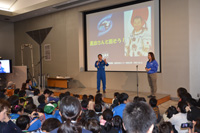
Hoshide's lecture in the morning at the TKSC's open house event (courtesy of JAXA)
April 21 marked the date of the TKSC's open house event, attended by as many as 12,073 visitors, a record for the Center. As a part of the event, Hoshide gave a lecture in the morning and one in the afternoon. With less than three months remaining until the launch, Hoshide introduced his current training and preparation status, and spoke about his aspirations for the upcoming expedition mission on the ISS.
During the morning lecture, Hoshide reminisced about when he was working at the TKSC as a staff member of NASDA, the predecessor of JAXA, and began training as an astronaut candidate and then later as an astronaut here. During the Q&A session, he was unable to call on everybody as too many listeners raised their hands to ask questions. Some of the questions asked of Hoshide concerned the hardest training he ever underwent and how to become an astronaut.
Hoshide's lecture in the afternoon was broadcast live with the leading host over the Internet. Hoshide answered questions through the Internet, thus making it a good opportunity for people other than the TKSC visitors to feel closer to Hoshide. In addition to the lectures, Hoshide toured the TKSC with the visitors for a deeper interpersonal exchange.

Hoshide at a press conference on April 25 (courtesy of JAXA)
On April 25, Hoshide held a press conference at the Nippon Press Center in Chiyoda, Tokyo, where he expressed his aspiration and goals.
Astronaut Wakata receives training on Kibo at the TKSC
Astronaut Wakata, assigned as a crew member for ISS Expedition 38/39, visited Japan in early April to receive training on the Japanese Experiment Module "Kibo" and enhance operational techniques at the TKSC.
As commander of ISS Expedition 39, Wakata will lead overall ISS operations and thus requires in-depth knowledge as a specialist regarding Kibo, the Japanese Experiment Module developed by JAXA.

Wakata and Russian cosmonauts receiving a lecture on the KOUNOTORI mission (courtesy of JAXA)
Through a series of training sessions lasting one week, Wakata updated his knowledge regarding the operation of each subsystem of Kibo, as well as the usage, handling, and maintenance of onboard equipment, and how to respond to contingency situations that might arise on Kibo.
Wakata also received training on the H-II Transfer Vehicle (HTV) "KOUNOTORI," and reviewed each stage of a mission -from launch to reentry into the atmosphere. In addition, Wakata checked the stowing configuration of cargo to be loaded onboard KOUNOTORI for delivery to the ISS, by using racks and mockup equipment (full-scale training models).
Astronaut Noguchi visits Saudi Arabia to prepare for the 25th ASE Planetary Congress
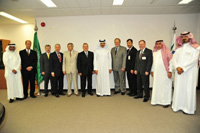
Noguchi (fourth from the right) and other members participating in the preparatory committee pose for a photo (courtesy of SPA)
In late April, Astronaut Noguchi visited Riyadh, Saudi Arabia, as a member of the Executive Committee of the Association of Space Explorers (ASE), in preparation for the upcoming 25th ASE Planetary Congress to be held there in November 2012.
ASE is an organization consisting of astronauts and cosmonauts from many countries, and holds a Planetary Congress almost every year. ASE works not only to contribute to space development and human space activity, but also to promote science and technology education, and raise awareness about environmental problems.
Noguchi and other members coordinated the time schedule and venue, and discussed and decided the main theme and details of items on the agenda. Noguchi will visit Riyadh in November to attend the congress.
New Astronauts at the Front-Line
Astronauts Kimiya Yui, Takuya Onishi, and Norishige Kanai
*Reports may be delayed depending on the training circumstances of each astronaut.

Preparation training was conducted for NASA's Extreme Environment Mission Operations (NEEMO) in June. During the NEEMO mission, various tasks are planned, including the simulation of asteroid exploration in the future. Therefore, we learned about the importance of asteroid exploration and received training on how to use tools for Extravehicular Activity (EVA) on an actual asteroid. Listening to the lecture on asteroid exploration, I felt that Japan is now acknowledged as the world's most advanced nation in the field of asteroid exploration. The many achievements of "HAYABUSA" were also introduced in the lecture. Without these achievements, I think it would be difficult to even begin preparing for manned asteroid exploration.
Prior to the mission, a swimming test was conducted as most mission activities will be conducted underwater. The criteria includes the following three requirements:
1. Swimming 400 meters within 12 minutes,
2. Swimming underwater for 25 meters, and
3. Treading water for 10 minutes.
Honestly, I'm not a very good swimmer, but I'm definitely expected to pass the test as the first kanji character of my name means "turtle," and my call sign is "shark." After practicing together with my crewmates, we took the test. All of my crewmates and I successfully passed the test.
For the NEEMO mission, training on first aid and cardiopulmonary resuscitation was also given, as one cannot rise to the surface immediately in case an unexpected situation occurs on the seabed, given the difference in atmospheric pressure. It is best if the opportunity to use such skills does not arise, but "anticipating and preparing for unforeseen circumstances in advance" is one of the secrets of success common to every field. So I will continue preparing for a successful mission by using my time effectively.
<Reference>
There are specific methods of simulating a weightless environment, and each has special features. In the Neutral Buoyancy Laboratory (NBL), a weightless environment is simulated using the buoyancy in water. However, since water has resistance unlike in space, the starting motion is difficult but stopping is easy (whereas in space the opposite is true.)
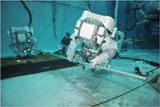
Tool training in the NBL
The Active Response Gravity Offload System (ARGOS) simulates weightlessness by suspending a person from the ceiling using a computer-controlled cable. Unlike in the NBL, there is little resistance and weightlessness cannot be simulated for certain postures, such as moving one's head upside down or turning one's body to the right and left. It is thus important to choose a suitable method of training in considering these differences.
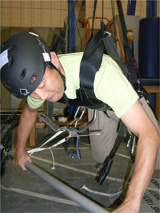
Tool training using ARGOS
(photo courtesy of JAXA/NASA)

Beginning this month, we will offer a monthly column about our training, other work, and my recent status. I would like to introduce our thoughts and the daily life of astronauts.
This month, I will discuss operation training by using a T-38 jet plane.
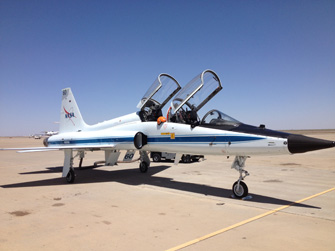
First, the question is raised, "why is aircraft operation training needed for astronauts?"
The photograph above shows the T-38 jet trainer. The T-38 aircraft has been used for more than 50 years to train many U.S. Air Force pilots. Fifty years ago (before I was born) marked the start of color television broadcasts in the world. Do you think such aging aircraft would still be operational? The T-38 has been repeatedly repaired and upgraded until now. The current T-38 used by NASA is a unique model, featuring a cockpit upgraded with the latest high-tech instrumentation and displays. The speedometer and altimeter are integrated in one display, with GPS equipment also mounted onboard.
The T-38 aircraft has two engines: one on the right side and one on the left side of the fuselage. As shown in the photograph, the T-38 is a twin-seater designed to carry two people. In our training, an American pilot astronaut or a flight instructor sits in the front seat, while an astronaut who is not a pilot or a non-American astronaut like me sits in the back. Since front visibility from the backseat is somewhat blocked, take-off and landing operations cannot be performed from the back. But in other phases, you can easily fly the aircraft by using the instrumentation.
One day in April, I had no scheduled training. However, I found that the backseat of the T-38 flown by my contemporary crewmate Scott Tingle was vacant. I decided to voluntarily undergo T-38 flight training all day long. As there are now fewer pilot astronauts and more backseat astronauts, the opportunities for flight training are very competitive and on a first-come-first-served basis. Therefore, you must always check the T-38 flight schedule and make a reservation in case there is a backseat available; otherwise, you'll lose a chance.
We arrived at Ellington Airfield at 7:00 a.m., one hour prior to the estimated departure time. The weather was good. There were likely to be no worries about the weather. I discussed and decided our flight route with Scott. Our plan was to depart Ellington, fly to Phoenix via El Paso, have lunch there, and then return via Midland. Once our route had been decided, we checked the information on each airport and discussed how to respond in emergency situations, such as in the case of a closed runway and what to do if one of the engines failed or the ham radio broke down.
In this way, we gathered all the necessary information and completed all preparations. Now it's time to go! While Scott began preparing to start the engines from the front seat, I was very busy in the back getting take-off permission from the control tower and setting up equipment in the cockpit. Then just after Scott started the engines, we had trouble.
A warning light indicated that the dynamo attached to the engine on the right side was not operating. Although Scott attempted troubleshooting as instructed by a maintenance person, the dynamo could not be restored. Regrettably, we had to shut down the engines.
In fact, even if one of the dynamos failed to function, electric power could still be supplied to all systems from the remaining one. And since the large battery mounted onboard the aircraft serves as the last resort should both dynamos fail, electric power can be supplied to the instrumentation and systems essential for flight (though the battery runs out in 20 minutes). In short, important systems have several backups, thereby making the aircraft a safe vehicle.
In our case, one engine system failed to operate and prevented us from starting the engines in that condition. The concept of "Safety first" is just as common to space flight, and one of the reasons why astronauts employ aircraft for training.
Fortunately, we were able to use a spare aircraft, and restarted our flight on that day. If unlucky, we would have wasted an opportunity for precious flight training...
Well, I noticed that I have used all of the space allotted to me. I will report on the flight next month.
To be continued...
(photo courtesy of JAXA/NASA)

Hello, I'm Norishige Kanai, a new astronaut. From this month, I will begin periodically reporting on my daily duties, the details of training, and other matters. This marks my memorial first one!
Unlike the astronauts of the Space Shuttle era, the astronauts for the International Space Station have many opportunities to travel frequently to the U.S., Russia, Japan, Europe, and Canada, which participate in the ISS Program, and receive training there. Therefore, I titled my report as "An Astronaut's Training Journey."
I'd like to introduce certain aspects of astronaut training that are not commonly known among the general public. I will also describe the atmosphere of each country's manned space program, including that of JAXA, and of course, that of NASA.
This April, I underwent training in Houston, Texas. The ISS is roughly divided into two segments: the American module including the modules of Japan and the European Space Agency (ESA), and the Russian module. My training this month was to learn about the "system" of the American module.
Note that I use the word "system." here. Conducting science experiments in a "Space Laboratory" is one of the major purposes of the ISS. When we consider the ISS as a huge "spacecraft," it is necessary to continue flying, improving the living environment, such as air for humans to live, water, room temperature, maintaining the communication system to communicate with flight controllers, and maintaining the precise altitude and attitude necessary to orbit the earth.
These functions of the ISS are categorized into several types of systems such as "Life support," "Communication," and "Navigation" that are all imperative for spacecraft operation, and on which astronauts receive training separately. This training may be similar to the education in schools, as we usually receive training according to specific subjects, such as mathematics, English, physics, and history. Astronauts must also pass an examination after training, as is the case with schools.
This marks the second time for me to learn about the American module, following my previous Astronaut Candidate Training, or ASCAN Training for short. Since the ISS has been rapidly upgraded (e.g., addition of a new module) as compared to when I underwent ASCAN Training, more convenient data processing has now been implemented. Thus, we always need to study.
This month I took exams for the "External Thermal Control System" that cools down the ISS to prevent overheating through the simultaneous operation of various types of hardware, and for "Daily Operation" to manage daily life. I successfully passed both!
In the "Daily Operation" training, I studied how to manage our food consumption so as not to become insufficient, how to dispose of garbage, how articles indispensable for daily life (e.g., memo paper, pencils, T-shirts worn every day, towels, toilet paper) are carried to the ISS, and how such articles are stored.
Speaking of "astronaut work," which tends to invoke the scene of space flight, most of our work entails training and engaging in various development duties on earth. Such training and duties on the ground are interesting experiences that you have never heard about or seen before (even though there are many severe times.)
Since I obtained a chance to report on my activities in my own words, I'd like to introduce part of my new experience of astronaut training on an ongoing basis.












